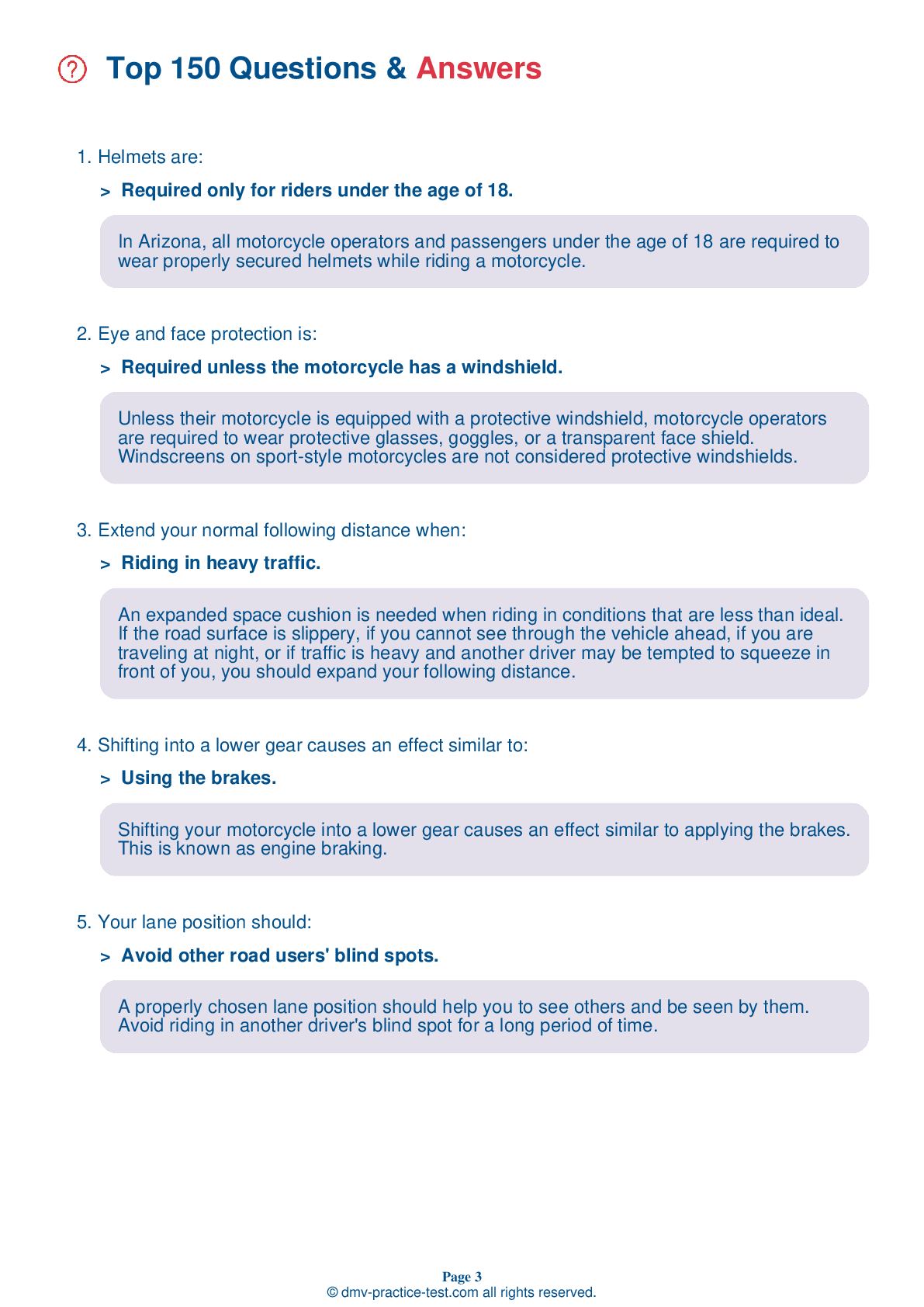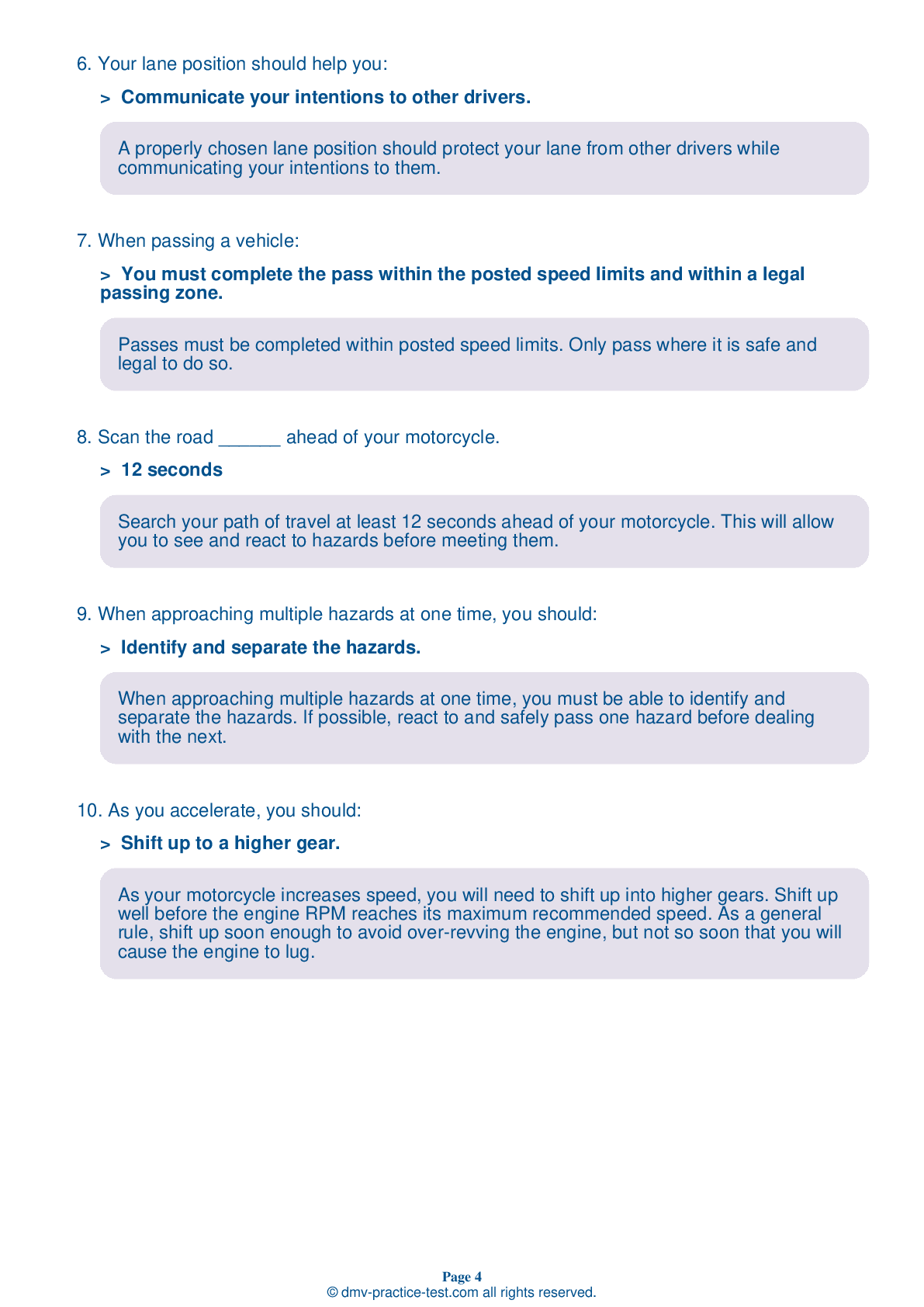DMV Permit Test #13
Motorcycle Test | License AZ 2025 | FREE Online Practice! #13 Page 3 of 4
Take this FREE motorcycle test (license in AZ 2025) to check your knowledge of the road rules. To improve your results, download a motorcycle handbook online, study theory, and practice for free on our website. Still worried about how to get a motorcycle license in Arizona in 2025? Check our website for more sample tests, train as much as possible, and boost your grades!
30
25
16
17 . When approaching an object or uneven surface that you cannot avoid, you should:
Rise slightly off the seat to allow your legs to absorb the shock.
If you cannot avoid riding over an obstacle or uneven surface, you should approach it at as close to a 90-degree angle as possible. Slow down as much as you can, make sure that your motorcycle is upright, and rise slightly off your seat so your knees can absorb some of the force of impact. Just before contact, roll on the throttle slightly to lighten the front end.
18 . Which of the following surfaces provides the best traction for a motorcycle?
Lane markings
A number of surfaces can provide poor traction for tires. Wet pavement; roads covered in loose gravel or sand; muddy, snowy, or icy areas; painted lane markings; and metal covers and plates in the road can be more hazardous for a motorcyclist than dry pavement.
19 . Maximum straight-line braking is done by:
Using the front and rear brakes at the same time while locking the rear wheel.
Maximum straight-line braking is accomplished by simultaneously applying both the front and rear brakes without locking either wheel.
20 . More than half of all motorcycle crashes:
Involve riders who have less than five months of experience on their motorcycles.
More than half of all motorcycle crashes involve riders with less than five months of experience on the motorcycle they were using. If you are riding a motorcycle for the first time, be sure to practice operating it in a controlled space before taking it on the road.
21 . When carrying a passenger, you should:
Sit anywhere.
When transporting a passenger, you should be sure that you have a seat that is large enough to carry two people without crowding. You should not sit any farther forward than you usually do.
22 . Proper clothing for riding offers all of the following, except:
Discomfort.
Proper clothing for riding can help protect you from injury in the event of a collision. It can also protect against routine hazards and discomforts, such as hot or cold weather.
23 . Use a turn signal:
Only if it is dark outside.
You should use a turn signal every time you plan to turn or change lanes, even if you think no one else is around to see it.
Need Motorcycle Insurance? No problem!
Compare the best rates in Arizona and find a personalized policy that meets your needs.
1. Are You Currently insured ?
2. Married ?
3. Do you own your Home?
4. Have you or a Family Member Honorably Served in U.S. Military ?
5. Your Name
6. Age
7. Zip code
Ranked by best match
2025 Arizona | Frequently Asked Questions
To acquire a motorcycle driver's license in Arizona, you must first apply for a motorcycle instruction permit. This involves passing a written test. After practicing with the permit, you can apply for a motorcycle license, which requires passing a vision test and a skills test. Alternatively, you can complete an approved motorcycle driver education program to bypass the skills test.
In Arizona, the minimum age for obtaining a motorcycle license is 16 years old. However, if you are under 18, you must first hold a motorcycle instruction permit for at least six months and complete an approved motorcycle driver education program or have your parent or guardian certify that you have completed at least 30 hours of motorcycle riding practice.
Yes, you do need a dedicated license for motorcycle riding in Arizona. You can either add a motorcycle endorsement to your current driver's license or obtain a standalone motorcycle license. This requires passing both a written knowledge test and a skills test, or completing an approved motorcycle training course.
To apply for a motorcycle driver's license in Arizona, you'll need several documents: proof of identity (like a birth certificate or passport), Social Security number, and proof of Arizona residency. If you're under 18, you'll also need a parent or guardian's signature on the application. Remember to bring the completion card if you've completed a Motorcycle Safety Foundation course.
Yes, you will need to take a written exam for a motorcycle license in Arizona. The test covers subjects like motorcycle operation, traffic laws, road signage, safe riding practices, and handling emergency situations. However, if you complete a Motorcycle Safety Foundation course successfully, you can bypass this written test.
The motorcycle written test in Arizona covers a variety of topics related to motorcycle safety and operation. These include understanding traffic signs and signals, rules of the road, safe riding techniques, handling dangerous situations, and the effects of alcohol and drugs on motorcycle operation. It's all designed to ensure you can operate a motorcycle safely.
Yes, in Arizona, you can substitute the written test with a Motorcycle Safety Foundation (MSF) course. Upon successful completion of the MSF course, you'll receive a Motorcycle Safety Foundation card, which you can present at the MVD to waive the written and on-cycle skills test for your motorcycle endorsement.
Enrolling in a motorcycle training course in Arizona typically involves finding an approved training provider, checking the course schedule, and registering either online or by phone. Some providers may require payment at the time of registration. You'll need a valid driver's license or permit, and some courses may have age restrictions. Always confirm details with your chosen provider.
No, you don't have to own a motorcycle to take the license test in Arizona. You can use any legally registered and insured motorcycle for the test. If the motorcycle isn't registered in your name, you'll need signed permission from the owner. The motorcycle must also pass a pre-trip inspection.
Yes, you can use a friend's motorcycle for the driver's license evaluation in Arizona. However, the motorcycle must be legally registered, insured, and pass a pre-trip inspection. You must also have a signed permission from the owner if the motorcycle isn't registered in your name.
Yes, in Arizona, the motorcycle driving exam tests specific handling skills. These include the ability to start and stop, turn and swerve, and perform quick stops. It also tests your ability to negotiate intersections, maneuver around obstacles, and understand road signs. These skills are necessary for safe motorcycle operation in various traffic conditions.
Yes, Arizona imposes limitations on new motorcycle drivers. Those under 18 must hold an instruction permit for at least six months before obtaining a motorcycle license. They must also complete a driver education program or have a parent or guardian certify they've had at least 30 hours of supervised riding, including 10 hours of night riding.
Yes, your Arizona motorcycle license permits you to ride a motorcycle out of state. All U.S states recognize each other's driver's licenses under the Full Faith and Credit Clause of the U.S Constitution. However, you should abide by the motorcycle laws of the state you are visiting, as they may vary from Arizona's.
In Arizona, helmet laws are age-specific. If you are 17 years old or younger, you are legally required to wear a helmet when operating or riding on a motorcycle. However, for those who are 18 years or older, wearing a helmet is optional but highly recommended for safety purposes.
Yes, Arizona offers two types of motorcycle licenses. Class M is for all motorcycles, while a Class G graduated driver license or a Class D operator license with a motorcycle endorsement (J) is for motor-driven cycles with engine displacement of less than 100cc. The type of license needed depends on the type of motorcycle you plan to ride.
Yes, in Arizona, you can add supplementary endorsements to your motorcycle license. This allows you to operate additional types of vehicles. For example, a "J" endorsement allows you to legally operate a vehicle that requires a motorcycle license but has an enclosed passenger compartment. Each endorsement requires passing a separate written and/or skills test.
Yes, the motorcycle license test in Arizona can be taken in languages other than English. The Arizona Department of Transportation offers the exam in several languages, including Spanish. However, it's recommended to contact your local Motor Vehicle Department to confirm the availability of the test in your preferred language.
An effective strategy to prepare for the motorcycle license test is to thoroughly study the Arizona Motorcycle Operator Manual. It covers all the topics included in the test. You can also take online practice tests to familiarize yourself with the format and types of questions. Additionally, taking a motorcycle safety course can provide practical experience and knowledge.
Yes, in Arizona, the motorcycle written exam is available in multiple languages to accommodate non-English speakers. However, it's advisable to contact the Arizona Motor Vehicle Department ahead of time to confirm the availability of your preferred language. They can provide you with the necessary resources or schedule a translator if needed.
If you don't pass the motorcycle written test in Arizona, you're allowed to retake it. However, you must wait at least one day before making another attempt. It's recommended to study the Arizona Motorcycle Operator Manual thoroughly before retaking the test to increase your chances of passing.



